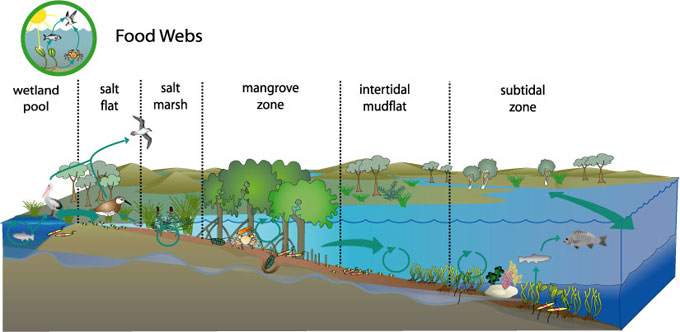
| Flow of carbon | Carbon is exchanged between freshwater and marine sources within an estuary and some is exported off shore Microbes decompose detritus, recycling nutrients and play a key role in detrital based food webs (Dennison and Abal, 1999) | ||
| Carbon cycling occurs within zones | Microbes decompose detritus, recycle nutrients and play a key role in detrital based food webs (Dennison and Abal, 1999) | ||
| Food web relay – carbon tends to move from high intertidal zones out into the estuary through a series of predator prey interactions (Connolly et al, 2006) | Birds connect estuaries, wetland pools and terrestrial coastal ecosystems by moving between the different locations (Sheaves et al, 2006) | ||
| Food web linkages between wetland pools and the estuary occur when water connections allow the transfer of debris and organisms between these areas (Sheaves et al, 2006) | Fish obtain their carbon from different sources depending on the availability of vegetation types in each system. For example, fish in Port Curtis tend to derive carbon from the abundant seagrass in this region (Connolley et al, 2006; Sheaves et al, 2006) |
References:
- Connolly, R.M., Currie, D.R., Danaher, K.F., Dunning, M., Melzer, A., Platten, J.R., Shearer, D., Stratford, P.J., Teasdale, P.R., Vandergragt, M. 2006 Intertidal wetlands of Port Curtis, an industrialised coastal city in central Queensland, Australia: ecological patterns and processes and their implications, Technical Report 43: CRC for Coastal Zone Estuary and Waterway Management, Brisbane, Queensland, Australia.
- Dennison, W.C., Abal, E.G. 1999, Moreton Bay Study: A Scientific Basis for the Healthy Waterways Campaign, South East Queensland Regional Water Quality Management Strategy, Brisbane, 246p.
- Sheaves et al, 2006 [in press]


